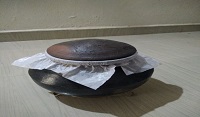Formulation and evaluation of fermented Ayurvedic formulation: Asava
Keywords:
Ayurvedic formulations, Asava, standardization, physico-chemical parametersAbstract
Asava, an Ayurvedic formulation is used since more than 3000 years for the treatment of various diseases. Due to accelerated commercialization, the assurances on safety and efficacy of Ayurvedic products have become an important issue. Growing awareness about harmful side effects of modern medicine has led to interest in Ayurveda at the international level as well as within India. It is prepared by using decoction of herbal drug and contains self generated alcohol. Although these formulations are mentioned in traditional literature and used regularly their scientific investigation and reporting is essential to strengthen Ayurveda in global market. Determination of qualitative as well as quantitative evaluation parameters of various asava is warranted to ensure the quality and safety of these preparations. Therefore, to achieve this, the world health organization advocates to undertake various standardization parameters. In present study attempt has been made for formulation and evaluation of prepared asava.
References
Handa SS. Extraction Technologies for Medicinal and Aromatic Plants. International Centre for Science and High Technology, Trieste, Italy, 2008: pp. 112- 20. 2. Anonymous. The Ayurvedic Pharmacopoeia of India. Appendix-2, Part-II, vol.-I, Ist Edition, National Institute of Science, Communication and Information Resources (NISCAIR), CSIR, Delhi, 2008: pp. 45 -47. 3. Mishra AK, Gupta A, Gupta V, Sannd R, Bansal P.Asava and Aristha:An Ayurvedic Medicine–An Overview.International J Pharm & Biol Arch 2010: 1(1): 24 30. 4. Anonymous, The Ayurvedic Pharmacopoeia of India. Appendix-2, Part-II, vol.-I, Ist Edition, National Institute of Science, Communication and Information Resources (NISCAIR), CSIR, Delhi, 2008: pp. 199. 5. Anonymous, The Ayurvedic Pharmacopoeia of India. Appendix-2, Tests and Determinations, Part-II, vol.-I, Ist Edition, National Institute of Science, Communication and Information Resources (NISCAIR), CSIR, Delhi, 2008; pp. 209. 6. Pourmorad F, Hosseinimehr S.J., Shahabimajd N., Antioxidant activity, phenol and flavonoid contents of some selected Iranian medicinal plants. Afr. J. Biotechnol 2006: 5:1142-1145. 7. Anonymous. Indian Pharmacopoeia of India. Ministry of Health& Welfare, Government of India, the Controller of Publications, Delhi, vol. II, 1996: 100-127. 8. Book of Pharmacognocy and phytochemistry 2nd edtion by S.L.Deore, Page No. 602 – 603. 9. Lal U.R., Tripathi S.M., Jachak S.M., Bhutani K.K., Singh I.P., HPLC analysis and standardization of arjunarishta- an Ayurvedic cardioprotective formulation. Sci Pharm 2009: 77: 605-616. 10. Mishra A.K., Gupta A., Gupta V., sand R., Bansal P. Asava and arishta: an Ayrvedic medicine- an overview. Int J Pharm Biol Arch. 2010; 1(1): 24-30. 11. Mukharjee P.K. and Wahile A. Integrated approaches towards drug development from Ayurveda and other Indian system of medicines. J Ethanopharmacol. 2006; 103 (1): 25-35. 12. Mulay S. and Khale A., Asavarishtas through improved fermentation technology, Int J Pharm Sci Res. 2011; 2(6): 1421-1425.



